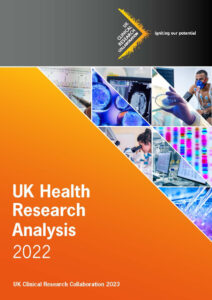Having a referenceable figure on how much the UK spends on a given research topic is handy for all sorts of publications. Charities find it particularly useful; ‘Only X% of UK health research is spent on Y’ is a great introduction when seeking support for your cause. I’ve even found a reference to UK Health Research Analysis reports in adverts for Nurofen.
UK Health Research Analysis reports are the largest analyses of UK health research funding. Our new report on 23,500 projects from 173 funding organisations, is the largest to date and shows over £5 billion of spend within the UK in 2022.

Front cover of the new UK Health Research Analysis report
Looking across the whole 18-year period of our reporting, we’ve seen increases for most areas of research. This includes long term upwards trends for prevention and translational research, which aims to turn fundamental discoveries into improvements in human health. But it also includes the signs of near-flat funding since 2009 and, for the first time, a small decrease in real terms health research funding since 2018.
But the reports aren’t just a handy source for quoting stats. They have real impact. Government policies often quote our data. Our findings can influence where public money is spent and show that policies have been delivered.
Getting a consistent picture
The Medical Research Council (MRC) leads on the creation of these reports on behalf of the UK Clinical Research Collaboration (UKCRC), which coordinates the efforts of major stakeholders who conduct research in the UK. Before this report series, individual organisations were able to say how much they spent on cancer research but the definitions, methodology or timescales varied, making a messy and inconsistent picture.
To fix this, in 2004 we designed the Health Research Classification System (HRCS). It aimed to unify the approach with enough detail to be useful but without unnecessary complexities.
We apply the system to every UK health research award, to classify them by health categories and research activities. This means that for every health research award that gets funded, I can tell you what type of research it is, how many fund it and who gets the funding.
Open access to everyone
I firmly believe the power of this work lies in keeping our reports and the underlying data public. It means that anyone can replicate the findings. It also allows for re-use of the dataset for other analyses. This saves countless resource-intensive hours for others interested in funding data and research policy.
While the reports’ main audience is policymakers, they have a much wider potential appeal. A researcher could use our data to find which funders are supporting work in their field. A patient could see how many charities support research into their disease. All in one place.
They also support the principles of publicly funded research being accessible to everyone that funds it. I like to say the UK Health Research Analysis reports are not just for data nerds like me, they are for everyone.
Ways to create collaboration
As you can imagine, reaching out to hundreds of organisations to collect the data for the reports can be daunting. However, I have three good ways to get organisations to work together:
Being part of these reports is an acknowledgement of being part of a wider ecosystem.
In my talks with other organisations, I emphasise the holistic aims and sense of community this brings. It helps convince organisations to take part, even if they are not health research specialists.
I’m doing what I can to make the process simple.
For organisations who can’t publish their award data we have an option for a narrative submission, so their contribution to the whole is still recognised. For those who can provide data, we keep requests simple and flexible but within a template format that can maintain consistency.
It’s a team effort.
I work closely with representatives from the 12 largest health funders to coordinate this work. This includes the fantastic Association of Medical Research Charities, who coordinate a combined submission from their entire membership, which cuts my job in half!
Building on two decades of analysis
I joined MRC as a data analyst, straight out of a research lab, to lead the third analysis in 2014. It was great to work with other organisations to not only produce the report but also review the HRCS itself. We revamped it with revised guidance and a new website in 2017.
Next year is the 20th anniversary for the HRCS and its use is expanding. We plan to use it to assess grants funded by our UK Research and Innovation ‘Securing better health, ageing and wellbeing’ strategic theme.
If I could oversee what happens next, I’d push for a publicly funded national database where research award data can be easily added by funders of any size. It would have a tool like HRCS built in, where automation is the default but with the opportunity to fill the gaps manually where an algorithm fails. That to me feels like the natural extension of the UK Health Research Analysis. An open, community-led and semi-automated way to provide the big picture view of the UK biomedical research landscape.
Find out more
Explore what compiling the UK Health Research Analysis involves and read the new report.
Top image: Credit: FatCamera, E+, via Getty Images.




